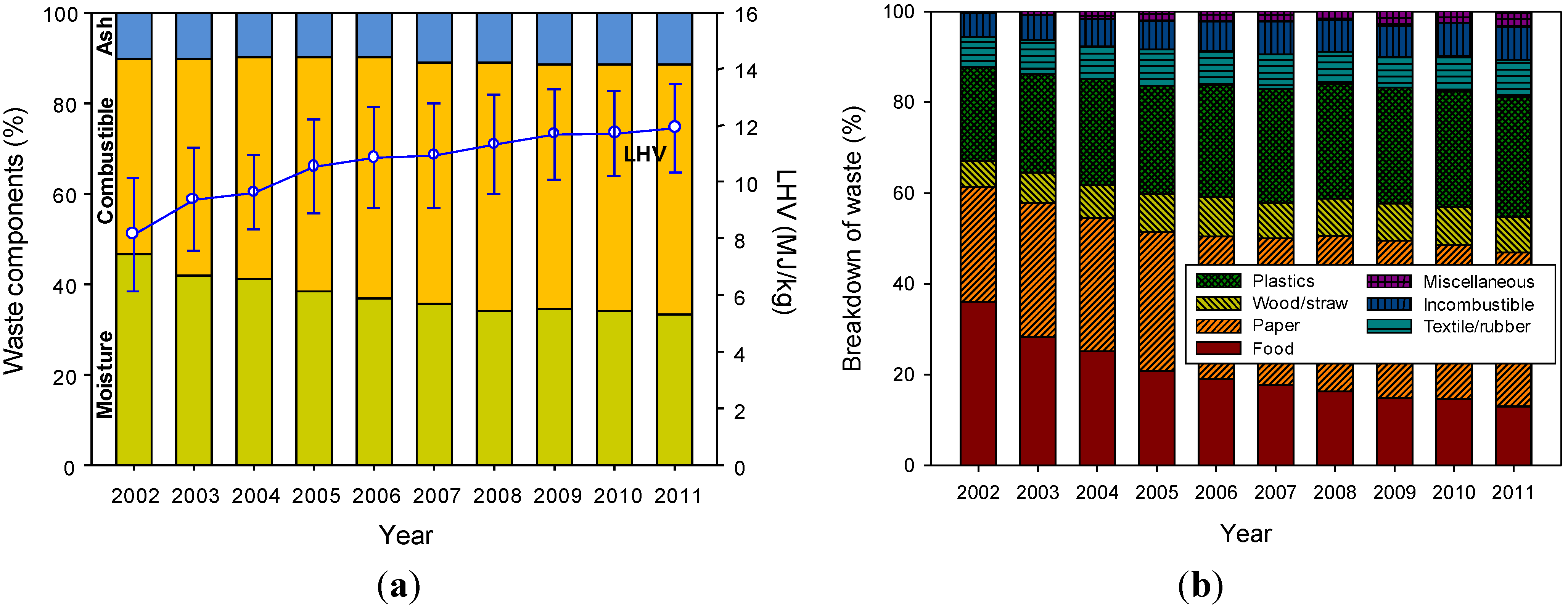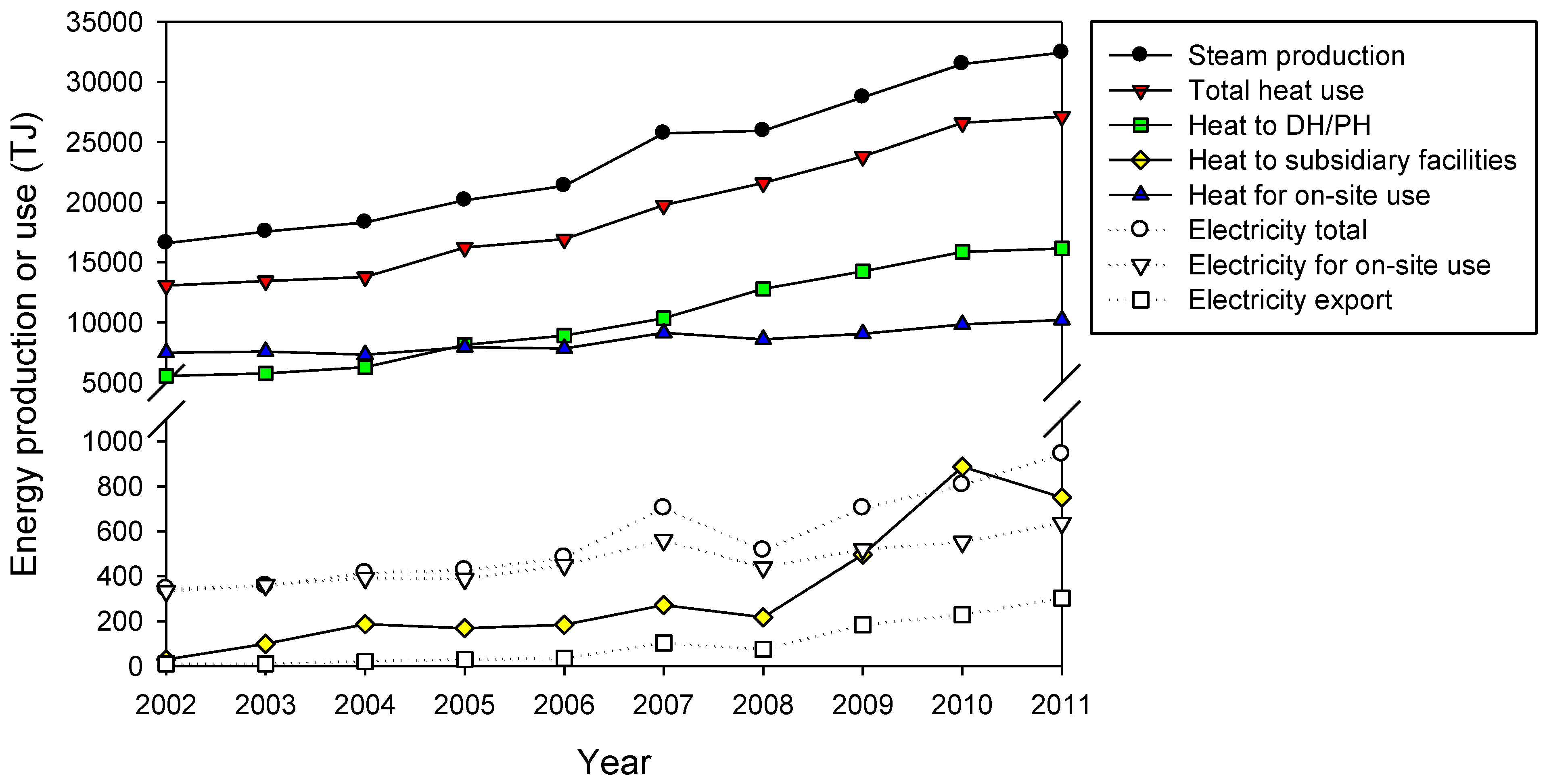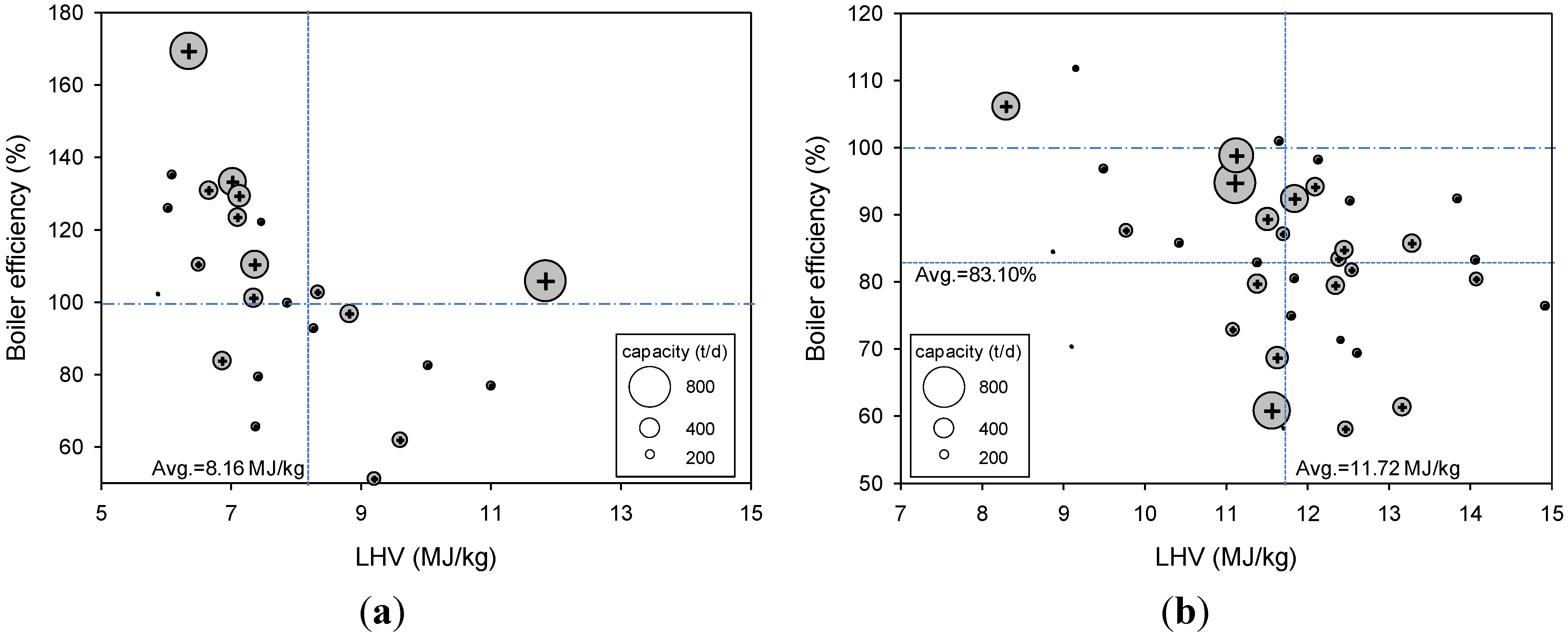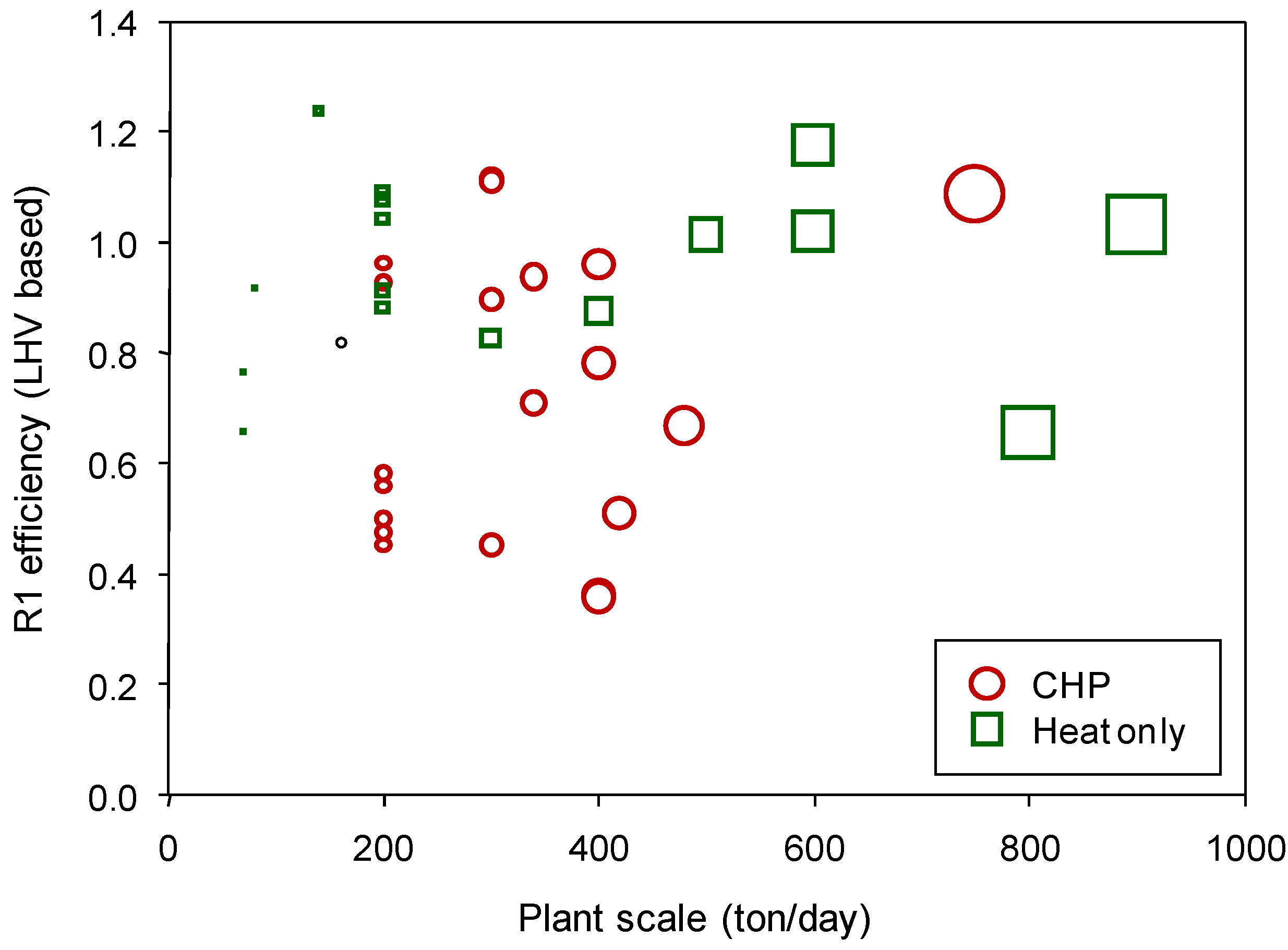Combined Heat and Power from Municipal Solid Waste: Current Status and Issues in South Korea
Abstract
:1. Introduction
2. Management of MSW in South Korea
| Year | 1997 | 2000 | 2003 | 2007 | 2010 | EU27 2010 [20] | |
|---|---|---|---|---|---|---|---|
| Generation | (t/day) | 47,896 | 46,438 | 50,736 | 50,346 | 49,159 | |
| (kg/day/capita) | 1.04 | 0.99 | 1.06 | 1.02 | 0.96 | 1.38 | |
| Management | Recycling (%) | 29.0 | 41.3 | 45.2 | 57.8 | 60.5 | 41.1 |
| Incineration (%) | 7.1 | 11.7 | 14.5 | 18.6 | 21.6 | 21.6 | |
| Landfill (%) | 63.9 | 47.0 | 40.3 | 23.6 | 17.9 | 37.3 | |

3. Energy production and Efficiencies of WtE from MSW in Korea
3.1. Energy Production from MSW

3.2. Korean WtE Energy Efficiencies
| Year | 2002 | 2010 | |
|---|---|---|---|
| Combined Heat and power | Number of plants | 13 | 25 |
| Annual waste throughput (kt) | 1,307 | 1,899 | |
| Thermal input of MSW (TJ) | 10,662 | 22,265 | |
| Heat production efficiency, ηheat (%) | 63.1 | 60.8 | |
| Power generation efficiency, ηpower (%) | 3.2 | 3.6 | |
| Heat-only production | Number of plants | 14 | 26 |
| Annual waste throughput (kt) | 867 | 1,494 | |
| Thermal input of MSW (TJ) | 7,073 | 17,511 | |
| Heat production efficiency, ηheat (%) | 89.2 | 74.9 | |

where Eprod = 1.1 Eheat + 2.6 Eelec

4. Issues of WtE in Korea
4.1. Increase in LHV
4.2. Steam Pressure and Power Generation Efficiency for a New Plant
| Plant (City) | Gangnam, Seoul | Jeonju | Ichon | Nonsan | |
|---|---|---|---|---|---|
| Capacity (t/h) | 300 × 3 units | 200 × 2 units | 150 × 2 units | 50 × 1 units | |
| Design properties of steam | Pressure (bar, gauge) | 40 | 21 | 30 | 7 |
| Temp (°C) | 400 | 216 | 300 | 170 | |
| Flow rate (t/h) | 131.4 | 59.3 | 60.6 | 6.6 | |
| Energy production | Heat-only | CHP | CHP | Heat-only | |
| Note | Heat exported to CHP system | Typical at large- scale plants for CHP or heat-only | Typical at small scales | ||
4.3. Improving the Energy Efficiency at Existing Plants
4.4. Transboundary Centralization of a WtE Plant
4.5. Renewable Energy from WtE
| Components in MSW | Paper | Wood | Food | TLa | Plastics | Incomb. | Misc. |
|---|---|---|---|---|---|---|---|
| wt % | 33.9 | 7.9 | 13.0 | 8.1 | 26.4 | 7.3 | 3.4 |
| Biogenic fraction b | 1.0 | 1.0 | 1.0 | 1.0 | 0.0 | - | 0.0 |
| LHV case 1b (MJ/kg) | 7.07 | 10.55 | 0.93 | 14.78 | 26.31 | - | 0 |
| LHV fractions (%) | 20.9 | 7.2 | 1.1 | 10.4 | 60.4 | - | 0 |
| Total biogenic LHV fraction | 39.6% | ||||||
| LHV case 2c | 9.79 | 9.74 | 1.82 | 14.18 | 29.24 | - | 12.67 |
| LHV fractions (%) | 24.4 | 5.6 | 1.7 | 8.5 | 56.7 | - | 3.1 |
| Total biogenic LHV fraction | 40.2% | ||||||
4. Conclusions
Acknowledgments
References
- Caneghem, J.V.; Brems, A.; Lievens, P.; Block, C.; Billen, P.; Vermeulen, I.; Dewil, R.; Baeyens, J.; Vandecasteele, C. Fluidized bed waste incinerators: Design, operational and environmental issues. Prog. Energy Comb. Sci. 2012, 38, 551–582. [Google Scholar] [CrossRef]
- Caputo, A.C.; Pelagagge, P.M. RDF production plants: I design and costs. Appl. Therm. Eng. 2002, 22, 423–437. [Google Scholar] [CrossRef]
- Arena, U. Process and technological aspects of municipal solid waste gasification. A review. Waste Manag. 2012, 32, 625–639. [Google Scholar] [CrossRef] [PubMed]
- ISWA Working Group Thermal Treatment of Waste. Management of Bottom Ash from WTE Plants; International Solid Waste Association (ISWA): Copenhagen, Denmark, 2006. [Google Scholar]
- Astrup, T. Management of APC Residues from W-t-E Plants, 2nd ed.; ISWA: Copenhagen, Denmark, 2008. [Google Scholar]
- Monni, S. From landfilling to waste incineration: Implications on GHG emissions of different actors. Int. J. Greenh. Gas Con. 2012, 8, 82–89. [Google Scholar] [CrossRef]
- Eurostat. Renewable Energy Statistics. Available online: http://epp.eurostat.ec.europa.eu/statistics_explained/index.php/Renewable_energy_statistics (accessed on 30 September 2012).
- Energy Information Administration. Renewable Energy Annual 2009; U.S. Department of Energy: Washington, DC, USA, 2012.
- International Energy Agency. Key World Energy Statistics 2009; International Energy Agency: Paris, France, 2009. [Google Scholar]
- ISWA Working Group on Thermal Treatment of Waste. Energy from Waste: State-of-the-Art-Report Statistics, 5th ed.; ISWA: Copenhagen, Denmark, 2006. [Google Scholar]
- Finney, K.N.; Sharifi, V.N.; Swithenbank, J.; Nolan, A.; White, S.; Ogden, S. Developments to an existing city-wide district energy network—Part I: Identification of potential expansions using heat mapping. Energy Convers. Manag. 2012, 62, 165–175. [Google Scholar] [CrossRef]
- Finney, K.N.; Chen, Q.; Sharifi, V.N.; Swithenbank, J.; Nolan, A.; White, S. Developments to an existing city-wide district energy network—Part II: Analysis of environmental and economic impacts. Energy Convers. Manag. 2012, 62, 176–184. [Google Scholar] [CrossRef]
- Directive 2008/98/EC of the European Parliament and the Council of 19 November 2008 on Waste and Repealing Certain Directives; Official Journal of the European Communities: Brussel, Belgium, 2008.
- Grosso, M.; Motta, A.; Rigamonti, L. Efficiency of energy recovery from waste incineration, in the light of the new Waste Framework Directive. Waste Manag. 2010, 30, 1238–1243. [Google Scholar] [CrossRef] [PubMed]
- Statistics Korea Home Page. Available online: http://kostat.go.kr (accessed on 30 September 2012).
- Korea New and Renewable Energy Center. New and Renewable Energy Statistics 2010 (in Korean); Korea Energy Management Corporation: Seoul, Korea, 2011. [Google Scholar]
- Waste to Energy Strategic Plan (in Korean); Korea Ministry of Environment: Seoul, Korea, 2008.
- National Energy Plan (2008–2030) (in Korean); Korea Prime Minister’s Office: Seoul, Korea, 2008.
- White Paper on Environment (in Korean); Korea Ministry of Environment: Seoul, Korea, 2011.
- Eurostat Web Page. Environmental Data Center on Waste. Available online: http://epp.eurostat.ec.europa.eu/ (accessed on 30 September 2012).
- Korea Incineration Conference. Annual Reports on Household Wastes Incineration Facilities. Available online: http://www.k-inc.co.kr/ (accessed on 30 September 2012).
- Ryu, C. Potential of municipal solid waste for renewable energy production and reduction of greenhouse gas emissions in South Korea. J. Air Waste Manag. Assoc. 2010, 60, 176–183. [Google Scholar] [CrossRef] [PubMed]
- Yoo, Y.D.; Yoon, Y.S.; Lee, H.H.; Shin, S.Y.; Sung, H.J.; Sung, N.G.; Hong, S.Y.; Han, I.H.; Kim, S.P.; Kim, J.H. Survey of MSW consumption (in Korean); Korea Energy Economics Institute, Ministry of Knowledge Economy: Seoul, Korea, 2012.
- Tabasoá, A.; Kropác, J.; Kermes, V.; Nemet, A.; Stehlík, P. Waste-to-energy technologies: Impact on environment. Energy 2012, 44, 146–155. [Google Scholar] [CrossRef]
- Guidelines on the Interpretation of the R1 Energy Efficiency Formula for Incineration Facilities Dedicated to the Processing of Municipal Solid Waste According to Annex II of Directive 2008/98/EC on Waste; European Commission: Brussels, Belgium, 2011.
- Park, K.S. Operation Case of Household Waste Incineration Facilities (in Korean); Korea Association of Waste to Energy Technology Autumn Workshop: Seoul, Korea, 2012. [Google Scholar]
- Takaoka, M.; Takeda, N.; Yamagata, N.; Masuda, T. Current status of waste power generation in Japan and its impact on carbon dioxide reduction. In Proceedings of the 6th International Conference on Combustion, Incineration/Pyrolysis, Emission and Climate Change, Kuala Lumpur, Malaysia, 26–29 July 2010.
- Hunsinger, H. A new technology for high efficient waste-to-energy plants. In Proceedings of the 6th International Conference on Combustion, Incineration/Pyrolysis, Emission and Climate Change, Kuala Lumpur, Malaysia, 26–29 July 2010.
- Veldman, H. High efficiency energy from waste. In Proceedings of the 2nd International Conference on Biomass and Waste, Oslo, Norway, 16–17 February 2010.
- Pavlas, M.; Touš, M.; Klimek, P.; Bébar, L. Waste incineration with production of clean and reliable energy. Clean Technol. Environ. Policy 2011, 13, 595–605. [Google Scholar] [CrossRef]
- Study on the Status of Waste to Energy Facilities and Efficient Energy Utilization; 11-1480000-001092-01; Korea Ministry of Environment: Seoul, Korea, 2009.
- Energy Information Administration. Methodology for Allocating Municipal Solid Waste to Biogenic and Non-Biogenic Energy; U.S. Department of Energy: Washington, DC, USA, 2007.
- CEN EN 15440:2011 Solid Recovered Fuels—Method for the Determination of Biomass Content; European Committee for Standardization: Brussels, Belgium, 2011.
© 2013 by the authors; licensee MDPI, Basel, Switzerland. This article is an open access article distributed under the terms and conditions of the Creative Commons Attribution license (http://creativecommons.org/licenses/by/3.0/).
Share and Cite
Ryu, C.; Shin, D. Combined Heat and Power from Municipal Solid Waste: Current Status and Issues in South Korea. Energies 2013, 6, 45-57. https://doi.org/10.3390/en6010045
Ryu C, Shin D. Combined Heat and Power from Municipal Solid Waste: Current Status and Issues in South Korea. Energies. 2013; 6(1):45-57. https://doi.org/10.3390/en6010045
Chicago/Turabian StyleRyu, Changkook, and Donghoon Shin. 2013. "Combined Heat and Power from Municipal Solid Waste: Current Status and Issues in South Korea" Energies 6, no. 1: 45-57. https://doi.org/10.3390/en6010045
APA StyleRyu, C., & Shin, D. (2013). Combined Heat and Power from Municipal Solid Waste: Current Status and Issues in South Korea. Energies, 6(1), 45-57. https://doi.org/10.3390/en6010045





